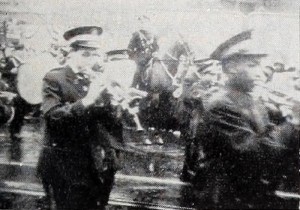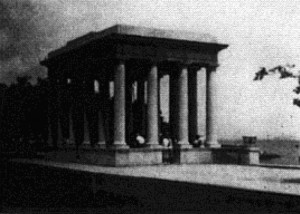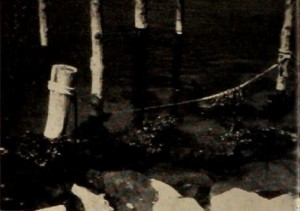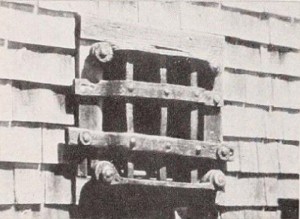"The 104 is a serious, factual recount of the landing of the Pilgrims at Plymouth, Mass., early in the 17th Century in terms of what one sees and finds in the vicinity of Plymouth Rock today. The rock itself is the legendary start of it all, followed by glimpses of wax figures that have been created to resemble some of the monuments and other scenes in the area" PSA Journal, Sept. 1965, 51.
"The Black Cat is a 25-minute version of Edgar Allen Poe's story by the same name and concerns a man who does away with his wife in what he believes to be the perfect crime, only to be outdone in the end by the family black cat. This low key, well dramatized version is the only 8mm film among the top ten and also received the MPD Scenario Film Award" PSA Journal, Sept. 1965, 50.

"Donald Volkman's film, A Breath of Spring, is a montage study of the vernal season in a city — in this case, Boston. But shots of the blowing skirt of a girl, the wind-whipped awning of a department store and the clothesline ballet of the Monday wash are universal. Mr. Volkman has truly brought imagination to his pictorial progression of spring, from melting snows in a churchyard to the full flowering of the sun-warmed earth and its people. His choice of musical accompaniment is especially notable, particularly with shots of running water in gutters and the Boston Pop's rendition of The Wearing of the Green with the sequence of a St. Patrick's Day parade. A Breath of Spring was created as a thesis in a course on motion pictures at Boston University, where Mr. Volkman is a student." Movie Makers, Dec. 1951, 411.
"Oscar Horowitz, of Newton, Mass., has taken the theme of Plymouth and developed it into the Movie of the Month. Opening with scenes of modern Plymouth we are reminded of the growth and prosperity that is our heritage. And this month, November, as the nation prepares to again celebrate Thanksgiving, Home Movies Magazine salutes Mr. Horovitz for producing a film that should remind one and all of the unrestricted freedom and opportunities that exist within our borders." Home Movies, Nov. 1950, 460.

"Dr. Crane has a humorous approach for a visit to Boston, Lexington, Concord, Bunker Hill, Plymouth Rock, and the Mayflower II. Each sequence is preceded by a title quotation from a famous writer, to wit: "Boston.....the hub of the solar system" by Holmes; "The fate of the nation was riding that night" by Longfellow; and ends with "the unconquerable rectitude" of the Plymouth Maiden and Edward Crane" PSA Journal, Oct. 1961, 48-49.

"Unity of theme is the striking characteristic of Jose M. Pavon's Menemsha — and its Achilles heel as well. The producer, in a series of beautifully composed scenes that seem to ebb and flow with the surging rhythm of the sea, has extracted the essence of a small fishing town on the coast of Martha's Vineyard. For almost its entire length, the film emphasizes the salt and the sea and the strange, lovely things of the ocean littoral with a feeling that Mr. Pavon accents brilliantly in double exposures of the shimmering sea water sweeping over even the deserted wharves. Unfortunately, Menemsha's unity breaks down a little as Mr. Pavon's camera roams too far afield and brings in elements that suggest fresh water and inland life rather than his original theme. A little cutting would tighten up a film that, technically and artistically, is a delicate and creative delight." Movie Makers, Dec. 1949, 454.

"In filming Nantucket, A Chapter from Early America, Russell T. Pansie chose a happy subject for Kodachrome — the weatherbeaten grays and pastel colors of the ancient buildings of Nantucket. Most color films are made with an effort to present colors as brilliantly as possible, but this picture is a delightful exception, and it is a notable example of the versatility of color film in the hands of a competent cameraman. In Nantucket, A Chapter from Early America, we see the orderly streets of the island, the historic buildings that date from the early Eighteenth Century, the mansions built by the prosperous sea captains of the Nineteenth Century and we glimpse the island's natural charm. But, in the brief footage that he wisely allowed himself, the cameraman has achieved more than an architectural study; he has reproduced the atmosphere of life as it was lived in the past." Movie Makers, Dec. 1943, 474.
"Bert Seckendorf is at his best documenting interesting places and events of this land of ours, and in editing and titling such films to impart sustaining interest on the screen. In 'Romance of Gloucester' he has focused his camera on both the interesting places and much of the contemporary life of Gloucester. His discerning lens brings satisfying multi-scene sequences of activities of Gloucester natives, instead of the one-shot treatment so often accorded such material by the uninitiated cine filmer. Result is, one experiences something in viewing this picture on the screen. Seckendorf's photography is clear-cut, discerning, and shows good taste in composition." American Cinematographer, May 1952, 222.